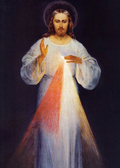|
There may be a number
of concerns with Faustina's 'Divine Mercy' image. The following are some items
that may be considered problematic with regard to the original image that
Faustina had painted...
1. Faustina's 'Divine Mercy' image is decidedly
untraditional
2. Faustina's 'Divine Mercy' image is oddly surrounded by
darkness (it has even been called 'spooky')
3. Faustina's 'Divine Mercy' image noticeably omits the
Sacred Heart
"Does it bother
you that St. Jacinta of
Fatima said before her death in 1920 that 'the Heart of Jesus wishes to be
venerated together with the
Immaculate Heart of Mary', but the image for Faustina's 1930 devotion shows
neither Jesus', nor Mary's hearts?" ["What's
Up With Faustina's Divine Mercy Devotion (2)? Another Approach For Getting To
The Truth" (MyCatholicSource User-Submitted Article/Catholic Controversy
Series)]
4. Unlike traditional Catholic images, Faustina's 'Divine
Mercy' image contains no trace of Christ's wounds
5. On Faustina's 'Divine Mercy' image, the fingers on the
right hand appear more similar to a greeting than a blessing
6. The prominent rays of light seem odd on Faustina's
'Divine Mercy' image, regardless of how they may be explained
7. The halo on Faustina's 'Divine Mercy' image seems
insufficient
8. In Faustina's 'Divine Mercy' image, the lighting on the
hair can appear like horns when seen from a distance...

9. Faustina's 'Divine Mercy' image is technically the
'Father Sopocko image' as Fr. Sopocko actually "dressed and posed for the
painting" that is supposedly of Jesus (for more on this,
try here)
10. According to online sources – including at least one
site that is dedicated to supporting Faustina's devotion – the
painter of Faustina's 'Divine Mercy' image, Eugeniusz Kazimirowski, was a
Freemason who later painted himself as Judas Iscariot (the traitor)
[Reminder:
Freemasonry is "an enemy of God, Church, and country" (Pope Leo XIII)]
11. Faustina's 'Divine Mercy' image is not
distinctly Catholic – it can be (and has been) used by Protestants
12. Faustina's 'Divine Mercy' image is associated with
questionable promises and may lend itself to superstition. For example, consider
these troubling quotes from Faustina's diary...
"By means of this
Image[!] I shall be granting many graces to souls; so, let every soul have
access to it." (#570)
"Today I saw the
glory of God which flows from the image[!]." (#1789)
"I am offering
people a vessel with which they are to keep coming for graces[!] to the fountain
of mercy. That vessel is this image with the signature: 'Jesus, I trust in
You.'" (#327)
"... and I
demand[!] the worship of My mercy through the solemn celebration of the ['Divine
Mercy'] Feast and through the veneration of the image which is painted." (#742)
["How exactly can such a thing be 'demanded'...? Even if the Church gives
approval to a devotion arising from an alleged private revelation, following its
dictates CANNOT be imposed on Catholics or 'demanded' of them." (What's
Up With Faustina's Divine Mercy Devotion (2)? Another Approach For Getting To
The Truth")]
"After a while,
Jesus said to me, Paint an image according to the pattern you see, with the
signature: Jesus, I trust in You. I desire that this image be venerated, first
in your chapel, and [then] throughout the world. I promise that the soul that
will venerate this image will not perish[!]. I also promise victory over [its]
enemies already here on earth, especially at the hour of death. I Myself will
defend it as My own glory." (#47-48)
As stated in "What's
Up With Faustina's Divine Mercy Devotion? Unanswered Questions & Things You May
Not Know" (emphasis added)...
"[We] know there
can be NO new path to salvation and simply venerating an image will NOT save
unrepentant sinners from hell! But, yet again, there is no call here to
repentance.
Also, we know
that God already instituted the sacraments to dispense His graces...[S]acraments
give graces of themselves, whereas sacramentals [such as images] do not give graces directly.
[As stated in the Baltimore Catechism, 'The difference between the Sacraments
and the sacramentals is: 1st, The Sacraments were instituted by Jesus Christ and
the sacramentals were instituted by the Church; 2nd, The Sacraments give grace
of themselves when we place no obstacle in the way; the sacramentals excite in
us pious dispositions, by means of which we may obtain grace.']"
"...it is good
to take note of the Baltimore Catechism's instruction concerning the possibility
of sinning when using sacramentals: 'Persons may sin in using Sacramentals
by using them in a way or for a purpose prohibited by the Church; also by
believing that the use of Sacramentals will save us in spite of our sinful
lives. We must remember that Sacramentals can aid us only through the blessing
the Church gives them and through the good dispositions they excite in us.
They have, therefore, no power in themselves, and to put too much confidence in
their use leads to superstition.'"
Furthermore, note that Faustina attributed an illicit
baptism to graces obtained when she prayed before the image (see Faustina's
diary, #916-917), and she also claimed she would have to "answer for a multitude
of souls" on the day of judgment if she neglected painting the image (see
Faustina's diary, #154).
It is sadly true that...
"Some Catholics
may wrongly think venerating an image, praying a chaplet, or spreading the
'Divine Mercy' devotion are 'salvation shortcuts' that will be sufficient to
save them without necessary amendment of their lives" ["What's
Up With Faustina's Divine Mercy Devotion (2)? Another Approach For Getting To
The Truth"]
13. Faustina's 'Divine Mercy' image was REJECTED by the
Church before the revolutionary
Second Vatican Council, along with her writings (which were NOT rejected due
to translation errors!)
Before closing, let's cover a couple common
objections...
1. Faustina herself was not pleased with image. This is
true, however: 1) Her displeasure did not concern the issues above, but rather
because the painting 'wasn't beautiful enough', and 2) Jesus supposedly told
Faustina that the image was acceptable...
"The work was
done for a few months and, finally, in June or July, 1934, the picture was
finished. Sister Faustina complained that the image was not as beautiful as her
vision but [the] Lord put her at ease saying that it was enough the way it was."
(Fr. Sopocko's Memoirs Concerning Faustina) [online source]
2. The image received a blessing. This is true, however...
"[A]dherents may
boast about the image being 'blessed' even before the Church initially rejected
Faustina's writings & image. But how is that a 'big deal'? If anyone with a
modicum of talent were to paint a picture of Jesus, would many parish priests
(or even bishops) refuse to bless it? So how can a blessing be some great
'validation' of the image?" [What's
Up With Faustina's Divine Mercy Devotion (2)? Another Approach For Getting To
The Truth]
And even if the image was blessed by a Pope before
Faustina's writings were rejected, this certainly does not constitute a
'formal approval' of Faustina's writings or any alleged promises associated
with the image. Besides the fact that the image was relatively new at the time,
the Church had yet to make a formal ruling on Faustina's devotion. It has also
been alleged (but not definitively confirmed) that Faustina's writings were
placed on the Index of Forbidden Books under the same pontificate. Even
if that cannot be firmly established, it IS indisputable that her writings & her
image were subsequently rejected by the Church, until after the
revolutionary Second Vatican Council.
In closing, are
Catholics really to believe that Jesus "demands(!)" that we venerate this
untraditional, dark/odd, heartless, Fr. Sopocko image painted by a Freemason? If
this doesn't throw up some red flags, what would?
Although it is true
that later representations of the 'Divine Mercy' image may cover over/alter
some disturbing items above (and various later images may also be arguably
feminine), this doesn't change the fact that the original image contains many
problematic issues that concern faithful Catholics, not to mention the many
issues with Faustina's diary (for some examples,
try here). And in fact, subsequent interpretations of the 'Divine Mercy' image may be based on Faustina's original & troubling 'Divine Mercy' image.
Note: For more regarding Faustina's 'Divine Mercy'
Devotion, try links below.
Reminder: We make no guarantee whatsoever regarding any item herein. Items herein may be the opinions of their authors and do not necessarily reflect our views.
All applicable items may be subject to change at any time without notice. Utilize any link(s) appearing on this page at your own risk.
For more terms information, see "Important Notice" below.
|



![Catechism of the Council of Trent [Book] (Click to buy & for more info.)](http://www.mycatholicsource.com/mcs/images/mkt/AZ-0043.jpg)

![Catholic Statues [Amazon Search] (Click to buy & for more info.)](http://www.mycatholicsource.com/mcs/images/mkt/AZ-0467-l-c.jpg)
![Scapulars [Amazon Search] (Click to buy & for more info.)](http://www.mycatholicsource.com/mcs/images/mkt/AZ-0462-l-c.jpg)
![Rosary [Amazon Search] (Click to buy & for more info.)](http://www.mycatholicsource.com/mcs/images/mkt/AZ-0029.jpg)
![Catholic Bracelets [Amazon Jewelry Search] (Click to buy & for more info.)](http://www.mycatholicsource.com/mcs/images/mkt/AZ-0258-l.jpg)
![Crucifix [Amazon Search] (Click to buy & for more info.)](http://www.mycatholicsource.com/mcs/images/mkt/AZ-0465-l.jpg)
![Catholic Medals [Amazon Jewelry Search] (Click to buy & for more info.)](http://www.mycatholicsource.com/mcs/images/mkt/AZ-0253-l.jpg)
![Crucifixes [Amazon Jewelry Search] (Click to buy & for more info.)](http://www.mycatholicsource.com/mcs/images/mkt/AZ-0255-l.jpg)

